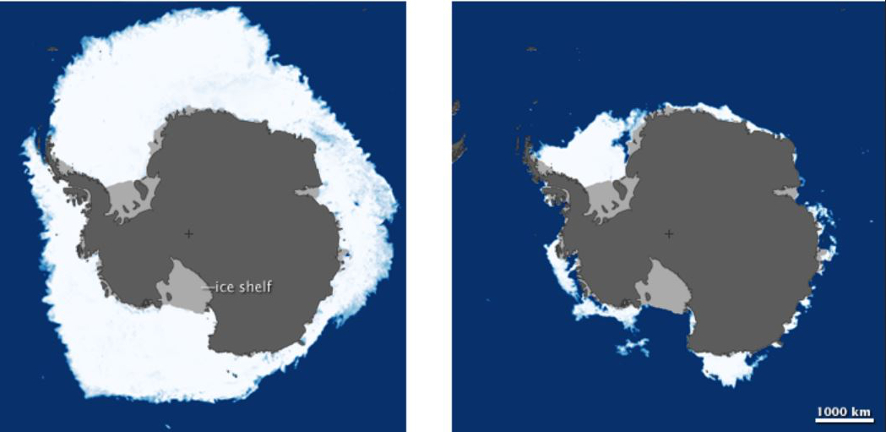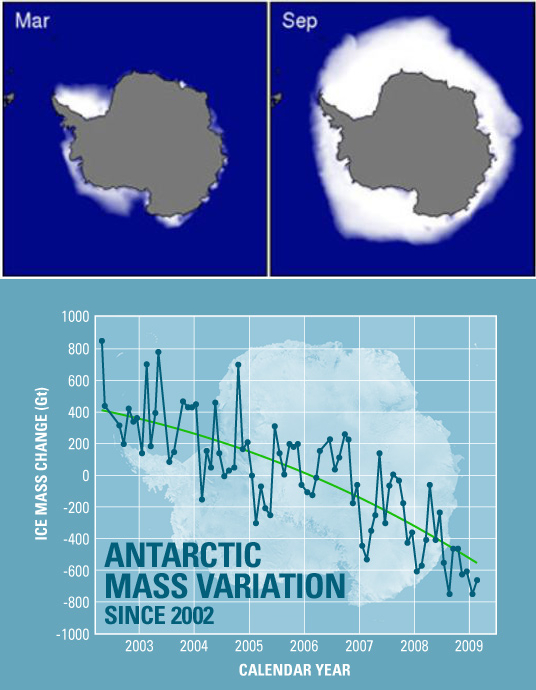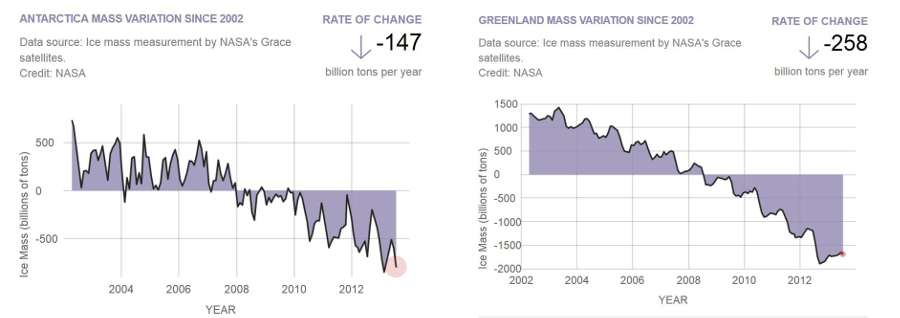again Walter? Again, you're trying to flog the Antarctic sea-ice extent? Why just 3 days ago you did this exact same thing and I replied with a rather lengthy post that closed with this question: "
c'mon Walter! When are you finally going to stop this continued denier play of yours over Antarctic sea-ice extent?". Apparently, you still have... an itch... to scratch! :mrgreen: I'll keep replying in kind to highlight images that speak to:
- the normal/typical yearly melt of Antarctic sea-ice extent... almost to its entirety showcasing there is no Antarctic multi-year ice accumulation concept (as exists within Arctic sea-ice).
- the Antarctic ice mass change (decrease)
these images:
of course Walter, you're (purposely) trying to draw some type of meaning, equivalency, relationship, etc., between Arctic and Antarctic sea-ice extent (where the Arctic is dramatically decreasing over a long-term melting trend) and the Antarctic where an increase in sea-ice extent has been seen in the last couple of years... which, again (as you know) has been attributed to warming... and, again (as you know) melts to essentially its entirety every year.
Walter, do you think it actually makes sense to try to equate... draw equivalencies... between sea-ice across the earth? Care to offer your thoughts on this and presume to attempt to draw some equivalency, some relationship between the Arctic and Antarctic? I wonder what the U.S. National Snow and Ice Data Center would say about your attempt in his regard, hey Walter?Question: Why don’t you publish a global sea ice extent number?
NSIDC Answer: The combined number, while easy to derive from our online posted data, is not useful as an analysis tool or indicator of climate trends. Looking at each region’s ice extent trends and its processes separately provides more insight into how and why ice extent is changing. Sea ice in the Arctic is governed by somewhat different processes than the sea ice around Antarctica, and the very different geography of the two poles plays a large role. Sea ice in the Arctic exists in a small ocean surrounded by land masses, with greater input of dust, aerosols, and soot than in the Southern Hemisphere. Sea ice in the Southern Hemisphere fringes an ice-covered continent, Antarctica, surrounded by open oceans. While both regions are affected by air, wind, and ocean, the systems and their patterns are inherently very different. Moreover, at any point in time, the two poles are in opposite seasons, and so a combined number would conflate summer and winter trends, or spring and autumn trends, for the two regions.
again, Walter... let me reinforce the key point you continue to (purposely) ignore concerning Antarctic sea-ice makeup as essentially made up of single-year ice (which, again, melts almost to its entirety each year):Scientists suggest it's principally first year sea-ice...
and deformed sea-ice. You know, the kind of ice that regularly melts in a subsequent years melting phase. And, as you know Walter, Antarctic sea-ice typically melts, almost to it's entirety, each and every year.Assessment of Ice Type: First Year versus Multiyear Floes
All of the surveyed floes are most likely to be first year (FY) floes based on multiple lines of evidence (Table S1, Fig S1, S2). While in most cases MY ice is distinguished from thinner FY ice by the deep snow cover, thick ice and high freeboard, discrimination is more difficult in our case where the FY ice was also thick and heavily deformed and most floes had a deep snow cover. This evidence includes imagery showing lack of ice in the region at the end of the previous summer, ice morphology, ice properties, and snow cover characteristics.
now, again Walter... it keeps being stated for you, yet you continue to ignore the scientific based reasons put forward as to why the Antarctic sea-ice extent has been increasing the last few years:
1 - the warming ocean is causing slightly fresher sea surface water around the margins of the continent’s melting ice shelves; additionally rain and snowfall increases are also freshening ocean water. These changes are altering the composition of the different layers in the ocean there causing less mixing between warm and cold layers and thus less melted sea and coastal land ice:Increasing Antarctic Sea Ice under Warming Atmospheric and Oceanic Conditions
The model shows that an increase in surface air temperature and downward longwave radiation results in an increase in the upper-ocean temperature and a decrease in sea ice growth, leading to a decrease in salt rejection from ice, in the upper-ocean salinity,and in the upper-ocean density. The reduced salt rejection and upper-ocean density and the enhanced thermohaline stratification tend to suppress convective overturning, leading to a decrease in the upward ocean heat transport and the ocean heat flux available to melt sea ice. The ice melting from ocean heat flux decreases faster than the ice growth does in the weakly stratified Southern Ocean, leading to an increase in the net ice production and hence an increase in ice mass. This mechanism is the main reason why the Antarctic sea ice has increased in spite of warming conditions both above and below during the period 1979–2004 and the extended period 1948–2004
2 - ozone levels decreasing over the Antarctic with an accompanying increase in the strength of cyclonic winds,
3 - this increasing cyclonic wind strength which, in turn, creates polynyas (open water areas) that freeze to increase sea-ice
again, c'mon Walter! When are you finally going to stop this continued denier play of yours over Antarctic sea-ice extent?







